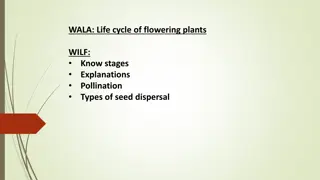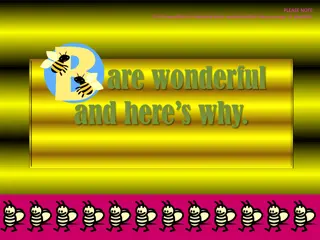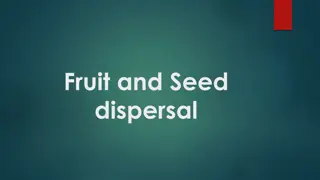Understanding Pollination: How Bees Help Plants Grow
Discover the fascinating relationship between bees and flowers, where bees play a vital role in pollination, aiding in the growth of plants and the production of fruits and seeds. Explore how bees need flowers for pollen and nectar, and how plants rely on bees to spread their pollen for reproduction. Get insights into the types of flowers bees prefer and how you can observe and learn more about pollination in your local environment.
Uploaded on Sep 10, 2024 | 0 Views
Download Presentation

Please find below an Image/Link to download the presentation.
The content on the website is provided AS IS for your information and personal use only. It may not be sold, licensed, or shared on other websites without obtaining consent from the author. Download presentation by click this link. If you encounter any issues during the download, it is possible that the publisher has removed the file from their server.
E N D
Presentation Transcript
Pollination Helping plants grow Photo: Amanda Fleming
What is pollination? Play the video to learn about pollination. Like Fruit? Thank a Bee! You might enjoy a delicious peach or slice of watermelon this summer, and it's largely in thanks to our pollinating friends: the BEES! ---------- Like SciShow? Want to help support us, and also get things to put on your walls, cover your torso and hold your liquids? Check out our awesome products over at DFTBA Records: http://dftba.com/SciShow Or help support us by becoming our patron on Patreon: https://www.patreon.com/scishow ---------- Looking for SciShow elsewhere on the internet? Facebook: http://www.facebook.com/scishow Twitter: http://www.twitter.com/scishow Tumblr: http://scishow.tumblr.com Instagram: http://instagram.com/thescishow SOURCES: http://www.life.illinois.edu/entomology/pollinators/docs/Pollination%20Activity%20Book.pdf http://easyscienceforkids.com/all-about-pollination/ http://www.nrcs.usda.gov/wps/portal/nrcs/main/national/plantsanimals/pollinate/ http://www.fs.fed.us/wildflowers/pollinators/What_is_Pollination/ http://www.fs.fed.us/wildflowers/pollinators/ IMAGES: https://commons.wikimedia.org/wiki/File%3AItalienische_S%C3%BC%C3%9Fkirschen.JPG https://commons.wikimedia.org/wiki/File%3AStrawberries_A.jpg https://commons.wikimedia.org/wiki/File%3ALily_Lilium_'Citronella'_Flower.jpg https://commons.wikimedia.org/wiki/File%3AAmaryllis_pistils.jpg
Bees and flowers are made for each other Bees need flowers. Bees eat pollen and nectar made by flowers. Plants need bees. Bees spread their pollen from one plant to another. By spreading pollen, plants can grow fruit and seeds to grow new plants. This is called pollination.
Bees and flowers are made for each other Can you see three ways bees and flowers are made for each other?
Honey bee favourites What kind of flowers do bees like? Bees like pollen and nectar. Bees need to get into the flower to get pollen and nectar. Bees can see some colours better than others. They can easily see blue, purple, white and yellow.
EXPLORE Go for a walk around your school, backyard or neighbourhood. What kind of flowers can you see? What can you see inside the flowers? Can you match any parts of flowers to the picture? Which flowers do you think bees might like? Why? Can you see any bees, birds or insects looking for food in any of the flowers?
MAKE Can you make or draw a flower that a honey bee would like? Tip: look at the list of things bees like (slide 6) to help you decide what kind of flower to make. You could use playdough, paper, lego or any other materials you can find. You could try to make a kind of flower that you already know or you could invent a new kind of flower. There are also flower templates on the next slide to get you started.
CREATE Waggle dancing honey bee! Bees are excellent communicators and use both smell and movement to convey messages. The queen s unique pheromones reassure the colony that she is alive and well. Pheromones also play an important role in protecting the hive and are used as a homing signal for foragers. But, of course, the most extraordinary method of communication is a bee s ability to dance with precision and show the exact location of forage. After returning with a new nectar source, a bee will perform a series of carefully choreographed movements, described as a round or waggle dance (depending on the distance) which will accurately pinpoint the source in relation to the sun and the hive. She will also share a sample of the nectar so that they can easily identify the smell and taste. Happy Beekeeping! Bees show other bees in their hive where the good flowers are by doing a special dance. It is called a Waggle Dance. https://honeyflow.com Can you make up a dance to show your classmates where to find good flowers or food at your school? You could plan your dance by drawing a diagram like this one Don t forget to show your classmates what each movement means before you do the dance.
ART COMPETITION What would New Zealand look like without honey bees and other insects and animals that pollinate flowers (pollination)? What plants wouldn t grow anymore? What would we eat? Can you create a picture showing what New Zealand looks like with pollinators (animals that do pollination) and how it would look different without pollinators? You can use the template provided to your teacher or your own paper. Send your picture to Apiculture NZ for a chance to win a prize.























